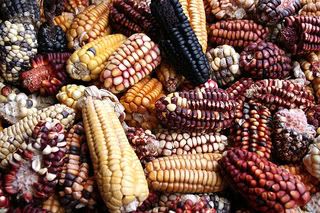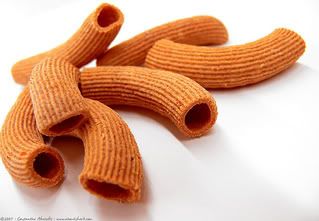Grains.... are they really the base of our food pyramid? Interesting article via marksdailyapple.com
What do you think? food for thought!
What do you think? food for thought!
Amber Waves of Pain
Order up! Yes, folks, it’s definitive guide time again. I’ve read your requests and am happy (as always) to oblige. Grab your coffee (or tea), and pull up a seat. Glad you’re with us.Food for Thought
Insulin, cholesterol, fats… They’re only the tip of the iceberg. I’ve had a few “definitive” topics up my sleeve for a while now, and grains are it for today. Yes, grains. I know we’ve given them a bad rap before, and it’s safe to say I’ll do it again here. Sometimes the truth hurts, but you know what they say about the messenger, right? Without further ado…
Grains. Every day we’re bombarded with them and their myriad of associations in American (and much of Western) culture: Wilford Brimley, Uncle Ben, the Sunbeam girl, the latest Wheaties athlete, a pastrami on rye, spaghetti dinners, buns for barbeque, corn on the cob, donuts, birthday cake, apple pie, amber waves of grain…. Gee, am I missing anything? Of course. So much, in fact, that it could – and usually does – take up the majority of supermarket square footage. (Not to mention those government farm subsidies, but that’s another post.) Yes, grains are solidly etched into our modern Western psyche – just not so much into our physiology.
Those of you who have been with us a while now know the evolutionary backdrop I mean here. We humans had the pleasure and occasional scourge of evolving within a hunter gatherer existence. We’re talking some 150,000 plus years of hunting and foraging. On the daily scavenge menu: meats, nuts, leafy greens, regional veggies, some tubers and roots, the occasional berries or seasonal fruits and seeds that other animals hadn’t decimated. (Ever seen a dog at an apple picking?) We ate what nature (in our respective locales) served up. The more filling, the better. And then around 10,000 years ago, the tide turned. Our forefathers and mothers were on the brink of ye olde Agricultural Revolution. And, over time, grains became king. But, as countless archaeological findings suggest, people became smaller and frailer as a result of this new agrarian, grain-fed existence.
Ten thousand years seems like a long time, doesn’t it? Think of all the house projects you could get done, the advanced degrees you could earn, the dinner party recipes you could try out, the books you could read. Almost oppressive, isn’t it? But our personal vantage point on the span of 10,000 years doesn’t mean much of anything when the context is evolution. It takes a lot to drastically change a major system in the human body. We’re talking a way bigger change than trying out the latest flavor of Malt-O-Meal. Grains were certainly not any substantial part of the human diet prior to the Agricultural Revolution. And even after grains became a large part of human existence, those who were deathly allergic to them or had zero capacity to take in their modest nutrient value were, in all likelihood, selected against. And pretty quickly at that. Those whose health was so compromised by grains that they were rendered infertile early in life were also washed out of the gene pool. That’s how it works. But if you can limp along long enough to procreate (which was considerably earlier then than it typically is now), that new fangled diet of grains got you through. No matter how stunted your growth was, how awful your teeth were, how prone you were to infection.
When I say humans didn’t evolve eating grains, I mean our digestive processes didn’t evolve to maximize the effectiveness of grain consumption. Just because you can tolerate grains to a certain degree, as just about all of us can (thanks to those earlier folks hitting the end of the genetic line), doesn’t mean your body was designed for them or that they’re truly healthy for you or – especially – that you can achieve optimum health through them. We’re not talking about what will allow you to hobble along. We’re talking about the foods that offer effective and efficient digestion and nutrient absorption in the body. And that’s all about evolutionary design. If you’re not after optimal health, you’re probably reading the wrong blog. But if you want to work with your body instead of unnecessarily tax it, if you want to focus your diet on the best foods with the most positive impact, you most definitely are reading the right blog. Now let’s continue.
Among my many beefs with grain, the first and foremost is the havoc it plays with insulin and other hormonal responses in the body. For the full picture, visit the previous Definitive Guide to Insulin from some months ago. Guess what? The same principles still hold. We developed the insulin response to help store excess nutrients and to take surplus (and potentially toxic) glucose out of the bloodstream. This was an adaptive trait. But it didn’t evolve to handle the massive amounts of carbs we throw at it now. And, yes, we’re talking mostly about grains. Unless you have a compulsive penchant for turnips, the average American’s majority of carb intake comes from grains.
The gist is this (as many of you know): Whatever the carbohydrate, it will eventually be broken down into glucose, either in the gut or the liver. But now it’s all dressed up with likely no place to go. Unless you just did a major workout or are finishing tying your running shoes as we speak (which would allow those grain-based carbs to be used in the restocking of depleted glycogen stores or burned as secondary fuel, respectively), that French baguette will more likely get stored as fat.
Why? Because carbohydrates elicit a physiological response that favors fat storage. That blasted baguette has already set off a strategic chain of hormonal events akin to a physiological-style Tom Clancy plot: the ambush of baguette glucose, the defensive maneuver of insulin, (if you ate the whole baguette, in particular) the entering reinforcements of adrenaline and cortisol. Why the drama? Because, remember, this was not the standard mode of nutrition in our body’s evolution. And every time it happens, the body is a little worse for the wear. This whole hormonal production taxes the adrenal system, the pancreas, the immune system, and results in a tiny amount of inflammation. We all know what we say about inflammation, right? (Hint: the blight of modern existence.)
And as for the nutritional value of grains? First off, they aren’t the complete nutritional sources they’re made out to be. Quite the contrary, grains have been associated with minerals deficiencies, perhaps because of high phytate levels. A diet high in grains may also reduce the body’s ability to process vitamin D.
Why not get the same nutrients from sources that don’t come back and bite you in the backside? If you have the choice between getting, say, B-vitamins from chicken or some “whole wheat” pasta, I’m going to say go with the chicken every time. Is pasta cheaper? Yes. Is it healthier? No. The B6 in chicken is more bioavailable, for one. The fact is, you pay too high a physiological price for the pasta source. Let’s get this point on the dinner table as well: whatever nutrients you can get from whole grains you can get in equal to greater amounts in other food. In terms of nutrient density, grains can’t hold a candle to a diverse diet of veggies and meats. (And if the label says otherwise, look closely because the product is fortified. Save your money and buy a good supplement instead.
But, wait, there’s more. Enter the lurker substances in grains that cause a lot of people a whole lot of obvious problems (and probably all of us some kind of damage over time). Grains, new evolutionarily-speaking, are frankly hard on the digestive system. (You say fiber, I say unnecessary roughage, but that’s only the half of it.) Enter gluten and lectins, both initiators of digestive mayhem, you might say. Gluten, the large, water-soluble protein that creates the sludge, err, elasticity in dough, is found in most common grains like wheat, rye and barley (and it’s the primary glue in wallpaper paste). Researchers now believe that a third of us are likely gluten intolerant/sensitive. That third of us (and I would suspect many more on some level) “react” to gluten with a perceptible inflammatory response. Over time, those who are gluten intolerant can develop a dismal array of medical conditions: dermatitis, joint pain, reproductive problems, acid reflux and other digestive conditions, autoimmune disorders, and Celiac disease. And that still doesn’t mean that the rest of us aren’t experiencing some milder negative effect that simply doesn’t manifest itself so obviously.
Now for lectins. Lectins are mild, natural toxins that aren’t limited to just grains but seem to be found in especially high levels in most common grain varieties. They serve as one more reason grains just aren’t worth all the trouble that comes with them. Lectins, researchers have found, inhibit the natural repair system of the GI tract, potentially leaving the rest of the body open to the impact of errant, wandering (i.e. unwanted) material from the digestive system, especially when these lectins “unlock” barriers to entry and allow larger undigested protein molecules into the bloodstream. This breach can initiate all kinds of immune-related havoc and is thought to be related to the development of autoimmune disorders. Some people are more sensitive to the damage of lectins than others, as in the case with gluten. Nonetheless, I’d say, over time we all pay the piper.
The bottom line is this: grains = carbs. Unnecessary at best, but flat out unhealthy at worst, they’re not the wholesome staples they’re made out to be. Talk about double taxation: Our bodies pay for what our trusty government subsidizes Big Agra for. The best – really the only way – to achieve a low carb, whole foods diet is to ditch the grains. (Your body will be better off without inflammation, the insulin roller coaster, not to mention the constant onslaught of creepy gluten and lectins.) A diet very low or entirely without grains (low-carb) has been shown to decrease risk for problems associated with diabetes, to lower blood pressure, alleviate heartburn symptoms, and shed abdominal fat. Finally, low carb diets have been associated with significant “reductions in a number of pro-inflammatory cytokines, chemokines, and adhesion molecules.”
The idea here is not to demonize grains. Well, O.K., it is. (But only because our society and medical establishment spends so much time exalting them.) Just as I choose to steer clear of grains as a regular part of my diet, I do occasionally indulge a bit. A tiny bit. And that’s where the Primal Blueprint enters: it’s about informed, not dictated choices. That French bread at an anniversary dinner, a sample of the pasta salad at your Uncle Billy’s steak fry, the saffron rice your daughter cooks for you when you visit her first apartment – they’re thoughtful, purposeful compromises. (And they’re perhaps very worth it for reasons that have nothing to do with the food itself.) The point of the Primal Blueprint if this: When you understand the metabolic effects of eating grains, you’re empowered to make informed decisions about the role grains will have in your diet. You’re free to enjoy good health and self-selected compromises with a clear conscience and full epicurean gusto!






No comments:
Post a Comment